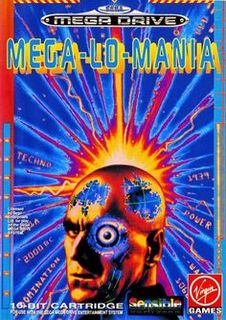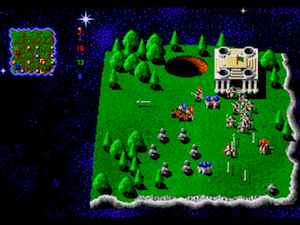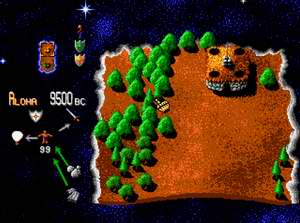
Mega-lo-Mania is a God game. There's some piffle about worlds coming into being bearing intelligent life, and how the universe's deities cluster around and fight for the right to control it. The plot is hardly serious, but then it's not meant to be. Each level has three islands to conquer, and the player is endowed with a small pool of computer people to begin the task. Any left unused carry over to the next level, which is handy for the later stages where time is of the essence. You are then awarded a base, or tower, from which to direct your operations. You can assign folks to mining, designing technologies, forming armies and what have you. The aim is to develop weapons and grow your population so you have a hefty enough army to invade your neighbours' square until, in the words of the game, you've "conquered the sector!" Simple, right? The problem is you're squaring off against up to three opponents who are all trying to do the same and, terror of terrors, not all squares are as equally well endowed with resources. You might merrily and painstakingly build up a mine and a factory to manufacture cannon only for your base to be invaded by 50 spear men. The result is curtains for you.

A further consideration the player must bear in mind is the end game. When your tower has reached 2001 (it was the future, once) and provided you either have other settlements or an army deployed somewhere, you can send your peeps into suspended animation. They wake up on the island of Armageddon at the end of the game to do battle with lasers with any opponents who also packed their folks into cold sleep. Generally speaking, because the AI isn't great the opposition are rubbish at doing this. During my playthrough 36 of my guys (out of 200+ who went into storage) survived. Only one other bothered earlier on in the game, and they must have had less than a dozen people to play with. The final battle was more a massacre than the promised mother of all battles, alas.
As an early real time strategy game, it is designed for quick play, of piling up your designs, manufacturing the most advanced weapons and taking it to the enemy. But when I was a little 'un determined to get full value of the £39.99, I quite liked playing long games, of slowly building up empires and military and toying with the much more stupid opponents. If you were the kind of kid that enjoyed tormenting ants, then Mega-lo-Mania is the game for you.
Mega-lo-Mania was noteworthy for a number of reasons. First, in a period where speech in video games was relatively rare, this was positively verbose and came packed to the gills with samples. Diplomacy, which began and ended at the striking of military alliances, was mostly a jovial affair. Of the four demigods you could play as/against, Madcap and Scarlet sounded quite gruff and serious. Cesar was every inch the comedy Italian with an overblown accent. And everyone's favourite was Oberon, who in his best Carry On camp voice would ask "do you want to be on my team?". And if he was turning you down, there came a very John Inman-esque "no, I don't think so". As he shared his name with Shakespeare's fairy king, perhaps camping him up sounded like a good idea at the time. The MegaDrive, oft noted for not having a fantastic sound chip, nevertheless rendered all the speech as clear as the Amiga version. The second point is its importance to real time strategy games in general. When it came out, the roost was ruled by an ageing-looking Populous and the first Civilization game on PC. The former was an RTS but relied on growing your population to overwhelm your opponent, while the latter was turn-based but was organised around a tech tree. Mega-lo-Mania married the two and was able to prepare the ground for the likes of Command and Conquer, Warcraft and Starcraft, which went on to dominate the RTS genre.

This begs the question, if Mega-lo-Mania was a big deal at the time, if it was an important milestone in the evolution of RTS games, and if it played a crucial role that influenced how control schemes need to work for strategy console releases, why is it largely forgotten? It could be that its creators, Sensible Software, met their demise at the close of the 1990s and so has sank into history as an orphan. That it never received a sequel, that the American name change nonsense damaged its ability to solidify a following around a brand identity. More likely, unfortunately, was while the game is very good it is relatively short and doesn't offer the kinds of variety Civilization and, to a lesser extent, Populous did. Whereas they required a variation in strategy and tactics (of sorts), you can complete Mega-lo-Mania by building quickly and attacking in overwhelming force almost every single time. Only the nuclear weapon levels offer a slight variation on the theme.
And that is a real shame, because Mega-lo-Mania does, if you'd forgive the clumsy allusion, deserve its place in the video game pantheon. It doesn't need worship, but its importance demands recognition.
No comments:
Post a Comment